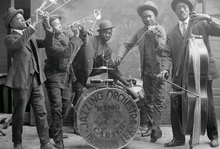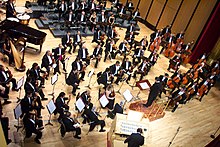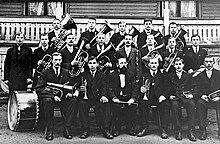This article has multiple issues.Please helpimprove itor discuss these issues on thetalk page.(Learn how and when to remove these messages)
|
Amusical ensemble,also known as amusic group,musical group,or abandis a group of people who performinstrumentaland/orvocal music,with the ensemble typically known by a distinct name. Some music ensembles consist solely of instrumentalists, such as thejazz quartetor theorchestra.Other music ensembles consist solely of singers, such aschoirsanddoo-wopgroups. In bothpopular musicandclassical music,there are ensembles in which both instrumentalists and singers perform, such as therock bandor the Baroque chamber group forbasso continuo(harpsichordandcello) and one or more singers. Inclassical music,trios or quartets either blend the sounds ofmusical instrumentfamilies (such aspiano,strings,andwind instruments) or group instruments from the same instrument family, such as string ensembles (e.g.,string quartet) or wind ensembles (e.g.,wind quintet). Some ensembles blend the sounds of a variety of instrument families, such as theorchestra,which uses astring section,brass instruments,woodwinds,andpercussion instruments,or theconcert band,which uses brass, woodwinds, and percussion. In jazz ensembles or combos, the instruments typically include wind instruments (one or moresaxophones,trumpets,etc.), one or two chordal "comping" instruments (electric guitar,acoustic guitar,piano, orHammond organ), abass instrument(bass guitarordouble bass), and a drummer or percussionist. Jazz ensembles may be solely instrumental, or they may consist of a group of instruments accompanying one or more singers. In rock and pop ensembles, usually calledrock bandsor pop bands, there are usually guitars and keyboards (piano, electric piano,Hammond organ,synthesizer,etc.), one or more singers, and arhythm sectionmade up of abass guitaranddrum kit.



Music ensembles typically have a leader. In jazz bands, rock and pop groups, and similar ensembles, this is theband leader.In classical music, orchestras, concert bands, and choirs are led by aconductor.In orchestra, theconcertmaster(principal first violin player) is the instrumentalist leader of the orchestra. In orchestras, the individual sections also have leaders, typically called the "principal" of the section (e.g., the leader of the viola section is called the "principal viola" ). Conductors are also used injazzbig bandsand in some very large rock or pop ensembles (e.g., a rock concert that includes astring section,ahorn section,and achoirthat accompanies a rock band's performance).
Classical chamber music
editIn Western classical music, smaller ensembles are calledchamber musicensembles. The termsduo,trio,quartet,quintet,sextet,septet,octet,nonet,anddecetdescribe groups of two up to ten musicians, respectively. A group of eleven musicians, such as found inThe Carnival of the Animals,is called anundecet,and a group of twelve is called aduodecet(seeLatin numerical prefixes). A soloist playing unaccompanied (e.g., a pianist playing a solo piano piece or a cellist playing aBach suite for unaccompanied cello) is not an ensemble because it only contains one musician.
Four parts
editStrings
editAstring quartetconsists of twoviolins,aviola,and acello.There is a vast body of music written for string quartets, making it an important genre inclassical music.
Wind
editA woodwind quartet usually features aflute,anoboe,aclarinet,and abassoon.A brass quartet features twotrumpets,atrombone,and atuba(orFrench horn (more commonly known as "horn" )). A saxophone quartet consists of asoprano saxophone,analto saxophone,atenor saxophone,and abaritone saxophone.
Five parts
editThe stringquintetis a common type of group. It is similar to the string quartet, but with an additional viola, cello, or more rarely, the addition of a double bass. Terms such as "piano quintet"or" clarinet quintet "frequently refer to a string quartetplusa fifth instrument.Mozart'sClarinet Quintetis similarly a piece written for an ensemble consisting of two violins, a viola, a cello, and a clarinet, the last being the exceptional addition to a "normal" string quartet.[citation needed]
Some other quintets in classical music are thewind quintet,usually consisting of flute, oboe, clarinet, bassoon, and horn; thebrass quintet,consisting of two trumpets, one horn, a trombone, and a tuba; and the reed quintet, consisting of an oboe, a soprano clarinet, a saxophone, a bass clarinet, and a bassoon.[1]
Six or more instruments
editClassical chamber ensembles of six (sextet), seven (septet), or eight musicians (octet) are fairly common; the use of latinate terms for larger groups is rare, except for the nonet (nine musicians). In most cases, a larger classical group is referred to as an orchestra of some type or a concert band. A small orchestra with fifteen to thirty members (violins, violas, four cellos, two or three double basses, and several woodwind or brass instruments) is called achamber orchestra.Asinfoniettausually denotes a somewhat smaller orchestra (though still not a chamber orchestra). Larger orchestras are calledsymphonyorchestras (see below) or philharmonic orchestras.[2]
Apops orchestrais an orchestra that mainly performs light classical music (often in abbreviated, simplified arrangements) and orchestralarrangementsandmedleysof popular jazz, music theater, or pop music songs.[clarification needed]Astring orchestrahas only string instruments, i.e., violins, violas, cellos, and double basses.
Asymphony orchestrais an ensemble usually comprising at least thirty musicians; the number of players is typically between fifty and ninety-five and may exceed one hundred. A symphony orchestra is divided into families of instruments. In the string family, there are sections of violins (I and II), violas, cellos (often eight), and basses (often from six to eight). The standardwoodwind sectionconsists of flutes (one doubling piccolo), oboes (one doubling English horn), soprano clarinets (one doubling bass clarinet), and bassoons (one doubling contrabassoon). The standardbrass sectionconsists of horns, trumpets, trombones, and tuba. Thepercussion sectionincludes thetimpani,bass drum,snare drum,and any other percussion instruments called for in a score (e.g., triangle,glockenspiel,chimes, cymbals, wood blocks, etc.). InBaroque music(1600–1750) and music from the earlyClassical period music(1750–1820), the percussion parts in orchestral works may only include timpani.[clarification needed]
Awind orchestraorconcert bandis a large classical ensemble generally made up of between 40 and 70 musicians from the woodwind, brass, and percussion families, along with the double bass. The concert band has a larger number and variety of wind instruments than the symphony orchestra but does not have a string section (although a singledouble bassis common in concert bands). The woodwind section of a concert band consists of piccolo, flutes, oboes (one doubling English horn), bassoons (one doubling contrabassoon), soprano clarinets (one doubling E♭clarinet, one doubling alto clarinet), bass clarinets (one doubling contrabass clarinet or contra-alto clarinet), alto saxophones (one doubling soprano saxophone), tenor saxophone, and baritone saxophone. The brass section consists of horns, trumpets or cornets, trombones, euphoniums, and tubas. The percussion section consists of the timpani, bass drum, snare drum, and any other percussion instruments called for in a score (e.g., triangle, glockenspiel, chimes, cymbals, wood blocks, etc.).
When orchestras performbaroque music(from the 17th century and early 18th century), they may also use aharpsichordorpipe organ,to play thecontinuopart. When orchestras perform Romantic-era music (from the 19th century), they may also useharpsor unusual instruments such as thewind machineorcannons.When orchestras perform music from the 20th century or the 21st century, occasionally instruments such as electric guitar,theremin,or even an electronic synthesizer may be used.
Vocal group
editAvocal groupis a performing ensemble ofvocalistswhosingand harmonize together. The first well-known vocals groups emerged in the 19th century, and the style had reached widespread popularity by the 1940s.[3]
Vocal groups can come in several different forms, including:[4]
Based on genders
edit- Boys' choir– vocal group of boys who have yet to begin puberty
- Boy band– vocal group consisting of (young) males
- Girl group– vocal group consisting of (young) females
- Co-ed group– vocal group consisting of both males and females, typically in their teens or early twenties
Based on project type
edit- Sub-unit – a group that is descended from the main group, with smaller number of members. Usually, all the members are from the main group.[5][6][7]
- Supergroup– a musical group formed with members who are already successful as solo artists or as members of other successful groups.
Others
edit- Choir– a group of voices. By analogy, sometimes a group of similar instruments in a symphony orchestra is referred to as a choir. For example, the woodwind instruments of a symphony orchestra could be called the woodwind choir.
- Doo-wopgroup
- Vocal quartet(as well as vocaltriosandquintets)
Other western musical ensembles
editA group that playspopular musicormilitary musicis usually called a band; adrum and bugle corpsis a type of the latter. These bands perform a wide range of music, ranging from arrangements of jazz orchestral, or popular music to military-style marches. Drum corps perform on brass and percussion instruments only. Drum and Bugle Corps incorporate costumes, hats, and pageantry in their performances.
Other band types include:
- Brass bands:groups consisting of around 30 brass and percussion players;
- Corps of drums,Fife and drums,Pipe bandsandDrum and bugle corpsare mostly ceremonial bands
- Jug bands;
- Marching bandsandmilitary bands,dating back to theOttoman military bands.
- MexicanMariachigroups typically consist of at least two violins, two trumpets, oneSpanish guitar,onevihuela(a high-pitched, five-string guitar), and oneGuitarrón(a Mexican acoustic bass that is roughly guitar-shaped), and one or more singers.
- Mexicanbandagroups
- String bands
SeeList of musical band typesfor more.
Role of women
editWomen have a high prominence in manypopular musicstyles as singers. However, professional women instrumentalists are uncommon in popular music, especially in rock genres such asheavy metal."[P]laying in a band is largely a male homosocial activity, that is, learning to play in a band is largely a peer-based... experience, shaped by existing sex-segregated friendship networks."[8]As well, rock music "...is often defined as a form of male rebellion vis-à-vis female bedroom culture."[9]In popular music, there has been a gendered "distinction between public (male) and private (female) participation" in music.[9]"[S]everal scholars have argued that men exclude women from bands or the bands' rehearsals, recordings, performances, and other social activities."[10]"Women are mainly regarded as passive and private consumers of allegedly slick, prefabricated – hence, inferior – pop music..., excluding them from participating as high-status rock musicians."[10]One of the reasons that there are rarely mixed gender bands is that "bands operate as tight-knit units in which homosocial solidarity – social bonds between people of the same sex... – plays a crucial role."[10]In the 1960s pop music scene, "[s]inging was sometimes an acceptable pastime for a girl, but playing an instrument...simply wasn't done."[11]
"The rebellion of rock music was largely a male rebellion; the women—often, in the 1950s and '60s, girls in their teens—in rock usually sang songs as personæ utterly dependent on their macho boyfriends..."[12]Philip Auslander says that "Although there were many women in rock by the late 1960s, most performed only as singers, a traditionally feminine position in popular music." Though some women played instruments in Americanall-female garage rock bands,none of these bands achieved more than regional success. So they "did not provide viable templates for women's on-going participation in rock".[13]: 2–3 About the gender composition ofheavy metal bands,it has been said that "[h]eavy metal performers are almost exclusively male"[14]"...[a]t least until the mid-1980s"[15]apart from "...exceptions such asGirlschool".[14]However, "...now [in the 2010s] maybe more than ever–strong metal women have put up their dukes and got down to it,"[16]"carv[ing] out a considerable place for [them]selves".[17] WhenSuzi Quatroemerged in 1973, "no other prominent female musician worked in rock simultaneously as a singer, instrumentalist, songwriter, and bandleader."[13]: 2 According to Auslander, she was "kicking down the male door in rock and roll and proving that a femalemusician... and this is a point I am extremely concerned about... could play as well if not better than the boys ".[13]: 3
See also
editReferences
edit- ^Thompson, Kristine (April 2021)."Blending the old and the new: the Sequoia Reed Quintet".Eastman Centennial.Retrieved2022-07-31.
- ^Raynor, Henry (1978).The Orchestra: a history.Scribner.p.[page needed].ISBN0-684-15535-4.
- ^Warner, Jay (2006).American Singing Groups: A History from 1940s to Today(1st ed.). Milwaukee: Hal Leonard Corp. pp. 1–3.ISBN9780634099786.
- ^Chilton, Martin (2022-08-03)."Pitch Perfect: A History Of Vocal Groups".uDiscover Music.Retrieved2022-11-28.
- ^Anoc, Aimee."What is a sub-unit in K-pop and why is this a buzzword online?".www.gmanetwork.com.Retrieved2024-02-13.
- ^"8 K-Pop Sub-Units So Brilliant That We Want More".Soompi.2022-07-03.Retrieved2024-02-13.
- ^"History of K-Pop: Sub-Units".The Kraze.2021-11-28.Retrieved2024-02-13.
- ^Schaap, Julian; Berkers, Pauwke (2014)."Grunting Alone? Online Gender Inequality in Extreme Metal Music".IASPM Journal.4(1): 101–102.doi:10.5429/2079-3871(2014)v4i1.8en.hdl:1765/51580.
- ^abSchaap, Julian; Berkers, Pauwke (2014)."Grunting Alone? Online Gender Inequality in Extreme Metal Music".IASPM Journal.4(1): 102.doi:10.5429/2079-3871(2014)v4i1.8en.hdl:1765/51580.
- ^abcSchaap, Julian; Berkers, Pauwke (2014)."Grunting Alone? Online Gender Inequality in Extreme Metal Music".IASPM Journal.4(1): 104.doi:10.5429/2079-3871(2014)v4i1.8en.hdl:1765/51580.
- ^White, Erika (2015-01-28)."Music History Primer: 3 Pioneering Female Songwriters of the '60s".REBEAT Magazine.Archivedfrom the original on 2015-12-22.Retrieved2016-01-20.
- ^Oglesbee, Frank W. (June 1999)."Suzi Quatro: A prototype in the archsheology of rock".Popular Music and Society.23(2): 29.doi:10.1080/03007769908591731.ISSN0300-7766.
- ^abc Auslander, Philip (28 January 2004)."I Wanna Be Your Man: Suzi Quatro's musical androgyny"(PDF).Popular Music.23(1). United Kingdom:Cambridge University Press:1–16.doi:10.1017/S0261143004000030.S2CID191508078.Archived fromthe original(PDF)on 24 May 2013.Retrieved25 April2012.
- ^abBrake, Mike (1990). "Heavy Metal Culture, Masculinity and Iconography". In Frith, Simon; Goodwin, Andrew (eds.).On Record: Rock, Pop and the Written Word.Routledge. pp.87–91.
- ^Walser, Robert (1993).Running with the Devil:Power, Gender and Madness in Heavy Metal Music.Wesleyan University Press. p. 76.
- ^Eddy, Chuck (1 July 2011). "Women of Metal".Spin.SpinMedia Group.
- ^Kelly, Kim (17 January 2013). "Queens of noise: heavy metal encourages heavy-hitting women".The Telegraph.
External links
edit- Helmut Kallmann;Patricia Wardrop; Jack Kopstein; Barclay Mcmillan (December 16, 2013)."Music Bands".Encyclopedia of Music in Canada.Historica Canada.RetrievedAugust 19,2019.